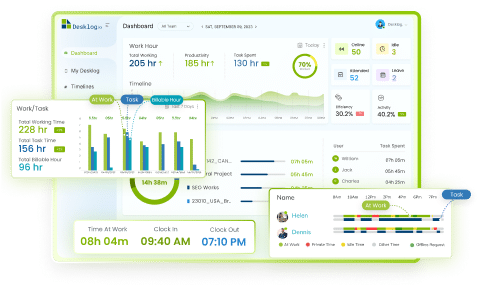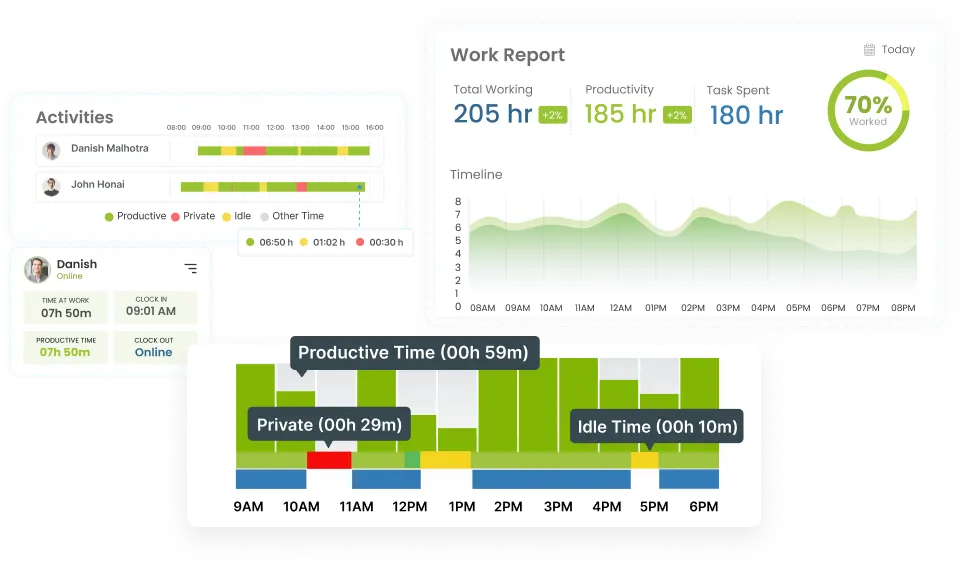Do you ever wonder if your employees are working at peak efficiency? The answer lies in a powerful metric: employee utilization rate.
This blog post will equip you with the knowledge to calculate utilization rate and explore why it’s crucial for driving productivity and success in the business landscape. Let’s dive in and discover how to get the most out of your workforce!
What is Utilization Rate?
The utilization rate is the percentage of an employee’s total billable hours spent productively. It can reflect the billing efficiency or the overall productive use of an individual or a firm.
In essence, for the business landscape, employee utilization rate measures the percentage of time that employees spend on productive work compared to their total available working hours. It provides a clear picture of employee efficiency and utilizing their time and resources to contribute to the organization’s goals.
It is also a metric used to measure the efficiency of resource usage. It’s commonly applied in various contexts such as manufacturing, services, or even personal productivity.
Types of Utilization Rate
There are two main types of utilization rates:
Billable Utilization Rate
This is the percentage of an employee’s total hours spent doing billable work, instead of internal or non-billable work. Billable work is any work that can be directly charged to a client, such as project time, consulting hours, or legal fees.

Resource Utilization Rate
This takes into account all of an employee’s time, both billable and non-billable. It is a way to measure and track how productive each employee is, and can be used to identify areas where employees may be underutilized or overloaded.

How to Calculate Utilization rate?
Let’s say you are running an organization with 20 employees, where they work 8 hours a day, 5 days a week.
If these employees work for 7 hours a day on average, the utilization rate would be calculated as:
Utilization Rate = (Actual Working Time / Available Time) x 100%
Utilization Rate = (7 hours / 8 hours) x 100% = 87.5%
So, in this example, the employee utilization rate is 87.5%, indicating that they have efficiently worked for 87.5% of the available time.
Similarly, in a service-based business like a consulting firm, utilization rate could refer to the percentage of billable hours worked by consultants compared to their total available hours.
For personal productivity, it could mean the percentage of time you spend on productive tasks compared to the total available time in a day.
| Utilization Rate Formula | The percentage of an employee’s available time allocated to productive, billable work. | Total Billable Hours/Total Hours Available |
|---|---|---|
| Capacity Utilization Formula | The average utilization rate across all employees within the organization. | Total of all employee utilization rates/ Total no of employees |
| Optimal Billing Rate | The hourly rate required for an organization to achieve profitability based on the average employee utilization | Resource costs +Overhead + Profit margin/Capacity utilization rate |
| Ideal Utilization Rate | The optimal utilization rate for an organization to meet its profit margin goal, based on a specified billing rate target. | Resource Costs+Overhead + profit margin/ Total available hours * Target billable rate |
What Is A Good Utilization Rate?
There’s no one-size-fits-all answer to what a “good” utilization rate is. It depends on several factors. However, a rate between 75% and 90% is considered to be a good utilization rate for people in production roles at many creative agencies.
It may differ for factors like:
Industry
Different industries have different norms. For example, creative agencies might target a billable utilization rate of 75-90% for production roles, while professional service firms might aim for 70-75%.
Employee Role
Managers or leaders might have lower billable rates due to strategic planning or administrative tasks.
Company Culture
Some companies prioritize maximizing billable hours, while others value a balance between productivity and employee well-being.
Here’s a general breakdown to give you an idea:
Billable Utilization Rate:
100%
This might indicate overworking and potential burnout. It could also suggest the need for additional staff.
70% – 90%
This is often considered a good range, balancing productivity with some buffer for non-billable tasks and unexpected situations.
Below 70%
This could suggest inefficiency. However, it could also be due to factors like project planning or skill development.
Resource Utilization Rate:
80% – 90%
This is a good range for many companies, allowing for both productive work and some non-billable activities.
Below 80%
This could suggest underutilization, but again, context matters. Consider if there’s a lot of downtime or if employees are waiting for new projects.
How to Improve Profitability by Analyzing Utilization Rate?
Every business owner dreams of increasing profitability. But how do you translate that dream into reality? The answer lies in a powerful metric: utilization rate. By understanding and optimizing this concept, you can attain a higher profitability within your business.
Here’s a roadmap to get you started:
1. Use the Capacity Utilization:

Let’s say a company has 5 billable employees, and the total utilization rate of these employees are 80%, 70%, 80%, 75%, and 85% each. To calculate the capacity utilization rate:
Capacity Utilization Rate = (80+70+80+75+85) / 5 = 78%
This metric provides insights into how effectively the company is utilizing its workforce. A higher capacity utilization rate suggests better efficiency in deploying available resources, while a lower rate may indicate potential areas for improvement in resource allocation or productivity.
2. Identify Your Idle Profit Margin

Suppose a company’s resource costs are $100,000, overhead costs are $50,000, and the ideal profit margin percentage is 20%.
Idle Profit Margin = ($100,000 + $50,000) x 0.20 = $30,000
This calculation helps in identifying the potential profit that could be earned if resources were fully utilized. It highlights the opportunity cost associated with underutilized resources.
3. Optimal Billing Rate (Dollars)

Considering the above scenario where resource costs are $100,000, overhead costs are $50,000, profit margin is 20%, and the average employee works 2500 hours annually.
Optimal Billing Rate = ($100,000 + $50,000 + $30,000) / 2500 = $72 per hour
This formula helps in determining the billing rate that covers all costs (resources, overhead) along with the desired profit margin, taking into account the average hours worked by employees.
4. Optimal Billing Rate (Percentage)

We calculated the optimal billing rate as $72 per hour in the above section, and also found the average utilization rate in the first step as 78%
So, Optimal Billing Rate / Utilization Rate = $72 / 0.78 = $92.30 per hour
Therefore, to achieve a 20% profit margin in your business, the optimal billing rate should be $92.30.
This step adjusts the optimal billing rate based on the actual utilization rate. If the utilization rate is lower than expected, the billing rate needs to be higher to maintain profitability.
Remember, this is just the initial steps. By consistently monitoring and optimizing your utilization rate, you can make long-term profitability.
Why Should You Track Employee Utilization Rate?
By closely analyzing and calculating employee utilization rates, organizations can gain valuable insights into their workforce’s efficiency and make informed decisions to drive performance and profitability.

Resource Optimization
By tracking employee utilization rates, businesses can identify underutilized or overutilized resources. This insight allows them to reallocate resources more effectively, ensuring that each employee’s skills and time are utilized to their fullest potential. This can lead to cost savings and increased productivity.

Performance Evaluation
Employee utilization rate serves as a valuable performance metric. It helps managers and team leaders evaluate individual and team performance objectively. Employees with consistently high utilization rates are likely to be more productive and efficient, while those with low utilization rates may require additional support or training.

Project Management
In project-based industries, monitoring employee utilization rates is crucial for effective project management. By tracking how much time employees spend on billable tasks versus non-billable, project managers can ensure that projects stay on track, deadlines are met, and resources are allocated efficiently.

Decision Making
Employee utilization rate provides valuable data for decision making at both strategic and operational levels. For example, it can help businesses determine staffing levels, identify areas for process improvement, and make informed decisions about hiring, training, and resource allocation.

Employee Engagement
Tracking employee utilization rates can also contribute to employee engagement and satisfaction. By optimizing utilization rates, businesses can create a work environment where employees feel motivated and fulfilled, leading to higher retention rates and improved morale.

Client Satisfaction
High employee utilization rates often correlate with improved client satisfaction. When employees are efficiently utilized and projects are delivered on time and within budget, clients are more likely to be satisfied with the quality of service provided.
Strategies for Improving Employee Utilization Rate
1. Set Clear Goals and Expectations
To improve employee utilization rate, it’s essential to establish clear goals and expectations for employees. Clearly define the types of tasks that contribute to billable hours or productive work and communicate these expectations to your team. Providing employees with a clear understanding of what is expected of them can help them prioritize their tasks and create backlogs. Moreover, they can focus on activities that contribute to higher utilization rates.
2. Streamline Work Processes
Identify and eliminate inefficiencies in work processes that may be hindering employee productivity. Streamlining workflows and automating tasks can help employees complete their work more efficiently, allowing them to dedicate more time to billable or productive activities. Regularly review and optimize work processes to ensure they are aligned with business objectives and support higher utilization rates.
3. Provide Training and Development Opportunities
Invest in training and development programs to enhance employees’ skills and capabilities. By providing employees with opportunities to acquire new skills or improve existing ones, you can increase their productivity and effectiveness in performing billable tasks. Training programs tailored to employees’ specific roles and responsibilities can help them become more proficient in their work, ultimately leading to higher utilization rates.
4. Implement Time Tracking Tools
Utilize time tracking tools to accurately track and analyze how employees are spending their time. Time tracking tools can provide valuable insights into employees’ work habits, identify areas of inefficiency, and track progress towards utilization rate goals. By regularly reviewing time tracking data, managers can identify opportunities for improvement and provide targeted feedback and support to employees.
5. Encourage Collaboration and Communication
Foster a culture of collaboration and open communication within the organization. Encourage employees to share information, collaborate on projects, and support each other in achieving common goals. By fostering a collaborative work environment, employees can leverage each other’s skills and expertise, leading to improved productivity and higher utilization rates.
6. Offer Flexible Work Arrangements
Consider offering flexible work arrangements, such as remote work or flexible hours, to accommodate employees’ individual preferences. These work arrangements can help employees better manage their time and achieve a better work-life balance. By providing employees with flexibility, you can empower them to work more efficiently and effectively, ultimately improving utilization rates.
Optimize Utilization Rate with Time Tracking Software
One powerful tool that can aid in this endeavor is time tracking software. By leveraging time tracking software effectively, organizations can gain valuable insights into how employees spend their time, identify areas for improvement, and ultimately optimize employee utilization rates. Here’s how time tracking software can come in handy for optimizing employee utilization rate:
1. Accurate Measurement of Productive Time
Time tracking software provides a reliable and accurate method for measuring productive time spent by employees on various tasks and projects. By tracking time spent on billable and non-billable tasks, organizations can gain a clear understanding of each employee’s contribution to revenue generation. This accurate measurement of productive time is essential for calculating and optimizing employee utilization rates.
2. Identifying Time Wasters and Inefficiencies
Time tracking software allows organizations to identify time-wasting activities and inefficiencies that may be hindering employee productivity. By analyzing time tracking data, managers can pinpoint common time sinks, such as excessive meetings, administrative tasks, or distractions, and take steps to address them. Eliminating or reducing time-wasting activities can free up more time for billable work, ultimately improving employee utilization rates.
3. Accurate Efficiency Tracking
This software allows organizations to accurately track employee efficiency by analyzing tasks and projects. By identifying areas where employees may be less efficient, managers can provide targeted training and support to improve performance. This focus on efficiency optimization contributes to higher utilization rates as employees become more productive in their work.
4. Project Tracking
Time tracking software enables organizations to track the progress of projects in real-time, allowing managers to identify potential bottlenecks or delays that may impact employee utilization rates. By tracking project timelines, managers can make proactive adjustments to ensure that projects stay on track and employees are effectively utilized throughout the project lifecycle.
5. Setting Realistic Utilization Targets
By analyzing historical time tracking data and performance metrics, managers can establish utilization rate goals that are achievable and aligned with business objectives. Setting realistic targets helps motivate employees and ensures that they are not unfairly pressured to meet unattainable utilization goals, ultimately fostering a more positive and productive work environment.
6. Tracking Workload and Capacity
By tracking hours worked and comparing them to individual capacity limits, managers can identify employees who are at risk of burnout or overwork. Adjusting workload distribution and providing support to employees with excessive workloads can prevent burnout, improve morale, and ultimately enhance employee utilization rates.
7. Facilitating Data Driven Decision Making
By analyzing time tracking data, managers can make informed decisions about staffing levels, project assignments, and resource allocation to optimize employee utilization rates. This data-driven approach ensures that decisions are based on objective evidence rather than assumptions, leading to more effective and efficient workforce management.
Closing Remarks
Understanding and effectively managing employee utilization rate is important for organizations striving to maximize productivity and efficiency in the workplace. It serves as a key performance metric that provides insights into overall business performance.
Start calculating your employee utilization rate today. Your organization’s future success depends on it.
FAQ
1What is the utilization rate (%)?
The utilization rate is the percentage of time that a resource or employee spends on productive activities compared to their total available time
2How do you calculate utilization rate?
Utilization rate is calculated by dividing the actual usage or productive time by the total available time and multiplying by 100%.
3Why is utilization rate important?
Utilization rate is important because it helps organizations measure efficiency, optimize resource allocation, and make informed decisions to drive productivity and profitability.
4 What is a good utilization rate at work?
A good utilization rate at work varies depending on the industry and type of work, but generally, a utilization rate above 80% is considered good.

















